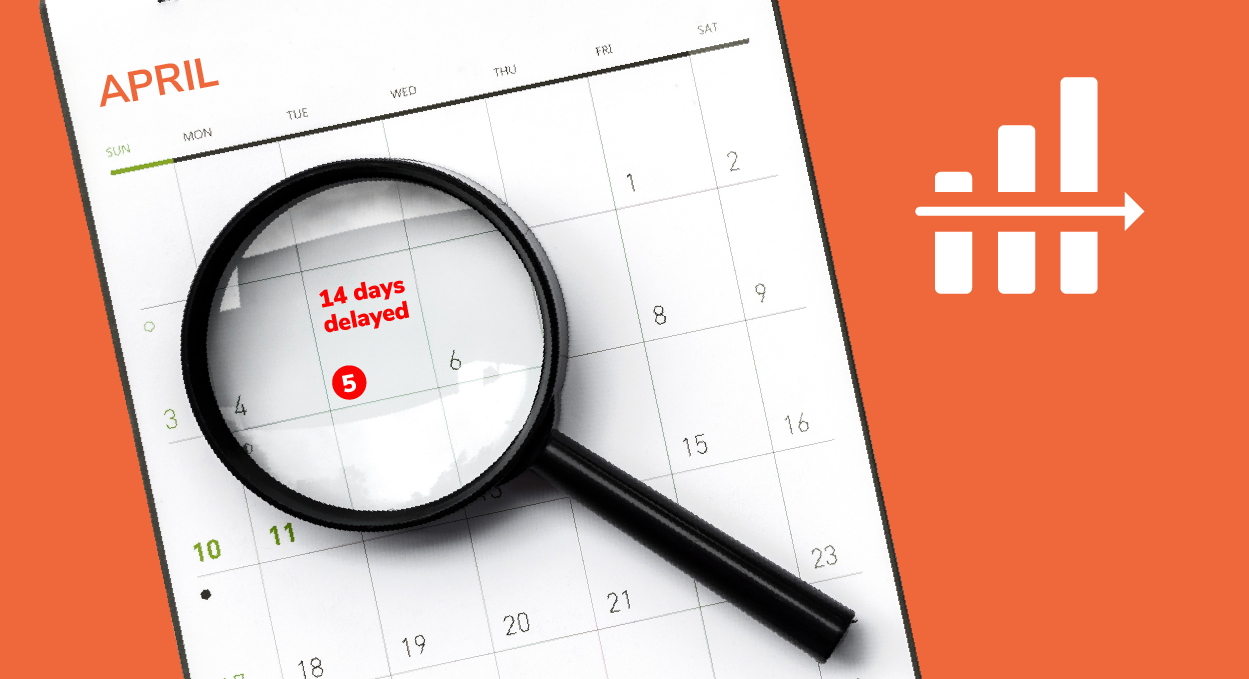Assessing how credit departments receive late payments can help them determine the efficiency of their collection methods. Metrics such as days sales outstanding (DSO), and average days delinquent (ADD) can help them know their current position and areas they need to improve on.
AR teams need to generate enough data to reduce late payments and optimize cash flow. They can track ADD to determine the duration that clients are taking to make late payments hence improving credit management.
Understanding average days delinquent (ADD)
ADD is the average number of days invoices are past due. AR staff use it to review customers’ accounts and review different accounts’ payment delinquency. The information obtained helps them improve a company’s payment collection, communication and invoicing processes.
Yet, it helps a company detect cash flow challenges and areas that it has to adjust its credit policies. For instance, a high ADD shows that a business is giving credit to clients who are not creditworthy. Alternatively, its payment collection strategies could be inefficient.
Analyzing ADD helps an investor understand industry trends and their competitors’ financial performance. It enables them to detect areas that a business is underperforming and re-strategize how they will improve their accounts receivables.
Calculating ADD and its components
The average days delinquent’s calculation process consists of three main steps. It is advisable to choose a low ADD as you review the results. But industry trends and norms in your company in the past several years will determine whether your ADD will be high or low. Follow these steps to get the right ADD;
This is the number of days that clients take without settling deb. Count them from when you made a credit sale.
DSO = (Average Accounts Receivable / Total Credit Sales)
x Number of Days
-
Calculate the best DSO
It is the DSO that your business would have if all customers made credit payments on time.
BPDSO = (Current Accounts Receivable / Annual Credit Sales)
x 365 Days
-
Calculate the ADD
Counter check your two previous results as you will use them in this step.
ADD = DSO – BPDSO
A real-world ADD example
A new smartphone company called Leotech makes $240,000 total net credit sales from January to March. It gets trade receivables amounting to $160,000 during the same period. Leotech’s DSO will be calculated as;
([$160,000 ÷ $240,000] × 90 days = 60 days)
Leotech’s current receivables are totaling $64,000. Therefore, its best possible days sales outstanding will be;
([$64,000÷$240,000] ×90 days= 24 days)
The mobile phone company’s AR team will use its DSO and BPDSO for the three months to calculate its ADD;
60 days- 24 days=36 days.
So, the company’s clients delay making credit payments by 36 days.
Why ADD matters
AR staff can evaluate ADD with several key metrics to determine your company’s collection process’ health. ADD is often analyzed using DSO to determine whether the company’s cash flow and credit collection are on the right track.
Generally, these two metrics follow the same direction. They help you know whether your collection strategies are less effective or they are improving. Still, the figures trend in different directions in certain businesses.
If this happens, it indicates that either the AR cycle has reduced or credit terms have changed rather than the collections’ efficiency improving. ADD is applicable in individual client accounts or in a customer base to track their accounts’ health.
Differentiating DSO and ADD
Some people often confuse ADD with DSO due to their usage. The two metrics depend on the time clients take to settle pending payments. Still, DSO assesses the average duration that clients take to pay bills. This includes early, late and on-time payments. On the other hand, ADD considers late payments only.
DSO offers an entrepreneur insight into how their average clients are good at making timely payments. It focuses on your client base’s average payment times. Nevertheless, ADD helps you understand your late payments’ severity. DSO aggregates clients’ payment duration. Hence, two subsets will cancel one another if some of your clients pay you late while others pay early.
This might prevent you from detecting the late payments issue on time. But using ADD to concentrate on clients’ late payments alone will come in handy. Normally, payment collection workers form insights based on the DSO and ADD.
When the two metrics follow the same direction, it shows that your collections effectiveness is either decreasing or increasing. An increase or decrease in ADD and DSO could be as a result of a change in the collections process. If the metrics change in different directions, this might be due to another factor like a significant change in your company’s payment terms. It includes setting new credit policies.
Problems in your clientele or internal operations can make the ADD and DSO to exceed your expectation. Some of the internal issues likely to cause such a change are inefficient communication with clients, understaffing and inconsistent payment collection processes.
Interpreting high vs. low ADD
Generally, a high ADD shows that clients are taking longer to pay their invoices. It indicates that your dunning efforts have improved slightly. Credit collectors can rank delinquent customers into different categories and send them emails asking them to settle payments fast.
Yet, a low ADD indicates that clients are making fast payments. Usually, collection and credit teams calculate DSO and ADD simultaneously. A decline or improvement in dunning can make ADD and DSO to be low or high.
A change in credit terms or temporary DSO improvement can make the two metrics move in different directions. Thus, it doesn’t always indicate that your collection efforts have improved. It is prudent to apply automated dunning with Chaser’s collections software and AI-based worklist prioritization to minimize DSO and recover credit fast.
This can be calculated as;
ADD = Days Sales Outstanding – Best Possible Days Sales Outstanding
Strategies to improve ADD
Follow these four tips to improve your company’s ADD and debtor management:
- Clear communication of payment deadlines: Failure to inform clients when you expect them to make payments will result so late payments. Still, you might not place a particular payment’s due date in a visible section of an invoice. Nevertheless, it is necessary to apply common financial terms like “end-of-month” or “Net 45” while stating your payment expectations.
-
Monitoring customer creditworthiness and dispute resolution with AI: A client might assume that they still qualify for credit since they were eligible for a particular credit level several months ago. Circumstances could have changed hence affecting their credit eligibility. So, it is important to have a real-time record of payment history and clients’ scorecards. Invoice-related conflicts can cause late payments.
Consider having a solution which will integrate machine learning and AI to evaluate disputes. This will cause fast dispute resolution. AI can assess a conflict and rank it according to its severity. Then, it will direct it to a suitable worker. This will increase your receivables and help you develop cordial relationships with clients.
Some customers might have a habit of making late payments. You need to adjust their payment plans and credit terms. Discuss this with them first to reach an agreement and enable them meet their financial obligations. Integrating Microsoft Dynamics 365 with an AR software will improve your credit control. Through it, you can rank clients’ payment risk and forecast late payments.
-
Adoption of AR automation solutions: Businesses with manual AR processes often take 30% longer to review invoices compared to companies with automation. The latest AR automation software sends invoices, dunning notices and payment reminders to clients fast. This helps in avoiding conflict.
- Alert clients about their pending payments: Indicate the exact amount that someone owes you on the invoice. You can create a self-service payment platform for customers. It should display credits, payment history, invoices and allow customers to settle debt. Add a direct link to the platform in your electronic communications. This will prevent misunderstandings and help clients make the right payments. Overpayments and underpayments can severe your relationship with customers.
Businesses with manual AR processes often take 30% longer to review invoices compared to companies with automation.
Boost your company’s credit management
Cash flow largely affects key business operations. 60 percent of small business owners in the UK face cash flow challenges. Monitoring indicators and KPIs with appropriate account receivables performance formula helps to avoid bankruptcy, debt and cash flow problems.
Credit collection teams require this information in real time. Also, they need to understand trade receivables well and update an old trial balance fast to track payments efficiently. Managers should easily access collection performance indicators like ADD, DSO, and collection effectiveness index (CEI). For more information on how Chaser’s AR automation solution can boost your company’s financial performance, book a demo or sign up for your 10-day free trial now.




